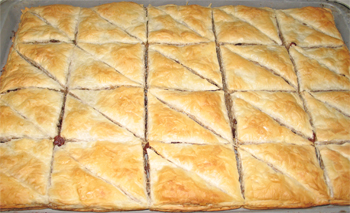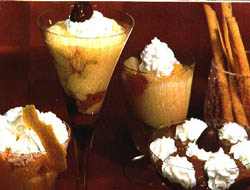|
|
Walnut
Baklava

Ingredients for Syrup:
2½
cups sugar
1½ cup water
1 teaspoon vanilla sugar
Juice of 1 lemon
Ingredients for Baklava:
1 box phillo pastry dough
4 cups chopped walnuts
1 cup sultana raisins
1 teaspoon cinnamon powder
2 tablespoons orange juice
3 tablespoons honey
1½ sticks unsalted butter, melted
Makes about 20 squares or
40 triangles.
Preparation:
- Combine sugar and water and
cook over medium heat. After syrup come to a boil
cook for 5 more minutes and remove from the heat.
Do not let it get too thick when it's still
cooking or it won't be absorbed by the phillo
dough.
- Cool syrup at room temperature
than mix in lemon juice. Cover and place in the refridgerator.
- Combine orange juice and honey.
Place walnuts and raisins in the medium
size bowl, sprinkle with cinnamom powder and mix well. Mix in honey and
orange juice mixture, one spoon at the time, so that
the walnuts stick together but are not
dripping.
- Mix melted butter and warm
water. Using a pastry brush, put a coat of butter on cookie pan. The
best cookie pan will be the one which is same size like philo pastry,
so you don't have to fold the pastry.
- Place 1 sheet of phillo on top
of butter. Brush sheet
with butter then put another sheet on top
of that one. Continue until you've used 1/4
of the phillo pastry dough.
- Spread the walnut mixture on
the phillo, leaving a tiny
bit of space at the edges. Cover with
the 2 sheets of philo pastry and repeat the process until you use all
of the walnut mixture. Reserve 5 to 6 sheets of phillo pastry for the
top. Cover walnut mixture withreserved phillo pastry, and brush each
sheet of
reserved philo pastry with butter mixture. Make sure the top of the
baklava has butter spread all
over it.
- Preheat oven to 350 degrees F.
- Cut the baklava in nice squares
or triangles and place in oven at 350 degrees
for about 15 to 18 minutes or until golden brown. Watch it closely and
don't let it burn.
- When the Baklava is done, pour
the syrup on top -
a little at a time using a spoon or
ladle.
TIP: It is
very important to
remember that when combine baklava and syrup always use hot baklava and
cold syrup or cold baklava and hot syrup combination. So if you forgot
to prepare syrup, or there is not enough syrup, don't worry, just cook
the syrup and pour hot syrup on cold baklava and it will be perfect.
NOTE: You
want the maximum amount of syrup to be
absorbed.
|
|

|
Did You Know?
|
The
history of baklava is not well-documented; it has been claimed by many
ethnic groups, but there is strong evidence that it is of Central Asian
Turkic origin, with its current form being developed in the imperial
kitchens of the Topkapi Palace.
In Turkey, Gaziantep is famous for its baklava and regarded there as
its native city, though it only appears to have been introduced to
Gaziantep from Damascus in 1871. In 2008, the Turkish patent office
registered a geographical indication certificate for Antep Baklava.
In Turkey, baklava is typically served with whipped cream and
pistachios.
In Bosnia-Herzegovina, most Bosnians like their baklava rich in nuts
and filling. Bosnians eat Baklava only on special occasions, mostly
eaten in the holy months of Ramadan (Ramazan in Bosnian) and Eid
(Bajram in Bosnian).
In Iran, a unique, dryer version of baklava is cooked and presented in
smaller diamond-shaped cuts flavored with rose water.
In Afghanistan, baklava is prepared into triangle-shaped pieces and is
lightly covered in crushed pistachio nuts.
|
|